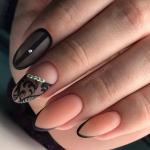Legionnaire tattoo. History of tattoos: from the Aborigines to the Avengers Roman-themed tattoos and their meaning
August 4, 2018
Decorative painting of the human body has long been used in many cultures since ancient times. Tattooing, as one of the methods of applying an indelible design, was a kind of identification of a person, belonging to one or another social group, and was also used in some initiation rites. Many historians note that this was a fairly common custom among various barbarian peoples. However, Roman tattoos have their own history.
 The earliest evidence of tattooing in Europe was discovered in the area of the modern Austro-Italian border, in the Etzal Alps, where in 1991 the well-preserved mummy of a man who lived more than 3,000 years ago and was nicknamed “Otzi” was found. Known as the "Similun Man" or "Tyrolean Ice Man", the remains of his body were inscribed with approximately 60 designs of parallel lines, dots and crosses.
The earliest evidence of tattooing in Europe was discovered in the area of the modern Austro-Italian border, in the Etzal Alps, where in 1991 the well-preserved mummy of a man who lived more than 3,000 years ago and was nicknamed “Otzi” was found. Known as the "Similun Man" or "Tyrolean Ice Man", the remains of his body were inscribed with approximately 60 designs of parallel lines, dots and crosses.
As you know, Marcus Tulius Cicero (106-43 BC), an ancient Roman philosopher and orator, said: “Graecia capta ferum victorem cepit”, that is, “Defeated Greece conquered the victor.” He meant that, having conquered the territory of Greece, the Romans were strongly influenced by ancient Greek culture, becoming, in turn, defeated. The phrase he said largely explains the almost identical vision of beauty in the Roman and Greek worlds. Tattoo is no exception, which, like some other cultural values, came to Rome from Greece.
This is interesting!
The Roman tattoo was called "stigma". Its application, as in Ancient Greece, was intended for various types of criminals and slaves in order to mark them as such. According to the ancient Roman chronicler Pliny the Elder (23-79 AD), slaves were usually branded with the initials of their master, because a slave was considered a human subspecies, working flesh, some semblance of an animal. However, the application of signs was regulated by official laws. For example, escaped slaves were tattooed with the letter “F” on their foreheads, that is, “fuggitivo” - fugitive.
In Ancient Rome, tattoos were incompatible with such concepts as a free person or a citizen. They could not be seen on the bodies of senators or Roman nobility. Emperor Caligula applied them to people of high rank only when they needed to be publicly punished or humiliated, since tattooing on the body was regarded as a symbol of inferiority and was considered the prerogative of barbarians. This is confirmed by many chroniclers in such works as “Germania” by Tacitus, “De bello Gallicum” by Caesar or “Bellorum Germaniae” by Pliny the Elder. In particular, it was noted that “the Gauls and Germans change their bodies with indelible paint to intimidate the Roman army, while the Roman army itself does not need to change its human appearance, since it is civil and fair.”  However, the conquest of more and more new territories had a significant impact on the spread of tattooing in the Roman Empire itself. Legionnaires, influenced by the customs of the conquered peoples, began to decorate their bodies with the words “Civis Romanus”, that is, “Citizen of Rome”. It was a kind of distinctive sign that made it possible to bury a legionnaire who fell on the battlefield with appropriate honors, or to identify a fleeing deserter. Subsequently, they began to add to it the symbol or name of the legion, as well as the name of the emperor - especially when he was loved and respected, although, according to Herodotus, such a practice was not approved by the authorities.
However, the conquest of more and more new territories had a significant impact on the spread of tattooing in the Roman Empire itself. Legionnaires, influenced by the customs of the conquered peoples, began to decorate their bodies with the words “Civis Romanus”, that is, “Citizen of Rome”. It was a kind of distinctive sign that made it possible to bury a legionnaire who fell on the battlefield with appropriate honors, or to identify a fleeing deserter. Subsequently, they began to add to it the symbol or name of the legion, as well as the name of the emperor - especially when he was loved and respected, although, according to Herodotus, such a practice was not approved by the authorities.
Before Christianity became the state religion, many followers who believed in the Savior began to independently apply various religious symbols to their bodies, marking themselves as witnesses of their own faith, and slaves doomed to hard physical labor in quarries or to gladiatorial fights were branded in its most prominent areas.

S.P.Q.R. - an abbreviation of the Latin phrase “Senatus Populus Que Romanus”, that is, “The Senate and citizens of Rome” or, literally, “The Senate and citizens are Rome”
After Emperor Constantine converted to Christianity (around 325 AD), many things began to change. He legislated that tattoos could only be on the arms or legs and completely prohibited their application on the face, since it “cannot be damaged, because it was created in the image and likeness of God,” as stated in the Bible. However, he did not forbid legionnaires from doing this, for whom tattooing had become a tradition and glorified the name of the legion.
Roman tattoos for Christians were finally banned by Pope Adrian I at the Council of Nicaea in 787, which was later confirmed by papal bulls. In their application, a connection was seen with paganism, which was considered a belief from the devil. From that time on, the practice of tattooing gradually began to disappear throughout the Apennine Peninsula. However, for many centuries, tattooing continued to be a distinctive sign of sailors, war veterans, criminals and some ethnic minorities; it was seen as an indicator of retardation and even some kind of mental disorder.
Roman numerals tattoo, forearm
Ancient Rome gave humanity legal rights, concrete and Roman numerals. Slender and laconic lines look beautiful. They are easily arranged into groups, creating an artistic effect.
Connoisseurs of the lettering style have a great love for Roman numerals. With their help, you can encrypt a message or memory of a significant event on the skin.
Roman numerals, how to choose your tattoo
Latin numbers can indicate a date, quantity, or encrypt entire concepts. If you understand this issue, you have an endless number of options for tattoos.
Creating the original image will take several hours. For viewers it will decorate the skin, and for you it will carry a secret message.
To choose your tattoo, Roman numerals must have meaning for you personally. You can encode your date of birth in the drawing. You can record a unique event that influenced your life.
The best way to decide is to look for an experienced craftsman working in lettering style. He will help you determine the location for application and develop a design for the numbers for you. Ultimately, you will have an original tattoo that carries meaning and serves as decoration.
Meaning of tattoo
Roman numeral tattoos in modern traditions carry a semantic meaning. This is not a simple set of strokes and lines. It contains data important to the carrier.
Common meanings for numbers for tattoos:
- 0 - symbol of non-existence, the beginning of a new one;
- I - strength, leadership and advantage, power;
- II is the number of awakening hidden potential and at the same time a symbol of contradiction;
- III - development, growth, flowering of talent;
- IV - hard work, organization and prudence;
- V - patroness of travelers, dreamers and explorers;
- VI - strong family, unification with others;
- VII - sacred number, awakening esoteric abilities;
- VIII - the number of lucky and happy people, an allegory of well-being;
- IX is a universal number in which longevity is encrypted.
With these meanings, you can reinforce positive effects in your life. For example, the date of birth of a child or meeting of a loved one.
By applying such marks on the body, a person wants to pay tribute to an event that changed his life.
Who is the tattoo suitable for?
Tattoos with dates are preferred by people with a pragmatic character. They are goal-oriented and value their time.
By decorating yourself with Roman numerals, you discover your hidden talents and create a protective sign on your body. This is one of the simplest. For example, your date of birth can serve as a connection to your family.
A pattern with numbers can emphasize femininity or enhance the feeling of masculinity. The perception of the image depends on the place of application. The style of the picture is considered important.
A pattern with numbers can emphasize femininity or enhance the feeling of masculinity. The perception of the image depends on the place of application. The style of the picture is considered important.
The tattoo looks good on fair skin. laconic stripes create an attractive contrast, enhancing the feeling of transparency.
Roman numbers are suitable for strong and independent people. By their means, the tattoo emphasizes the strong-willed character of the owner.
How to diversify your tattoo
If you want to get a date tattoo and want to diversify the design, you should think about additional elements. For example, the numbers can be placed as a straight line along the forearm.
Places of application
The most common place to place the number is the wrist. The drawing starts vertically or horizontally. Decorating the hand creates an attractive visual effect. The second place on the hand for a tattoo is the back of the hand or forearm.
 Number tattoo on forearm
Number tattoo on forearm Roman numeral tattoo, old school
Roman numeral tattoo, old school Number tattoo on hand
Number tattoo on hand Number tattoo on neck
Number tattoo on neck Roman numerals tattoo on heels
Roman numerals tattoo on heels Roman numerals tattoo on shoulder blade
Roman numerals tattoo on shoulder blade Lettering and Roman numerals tattoo
Lettering and Roman numerals tattoo photo from: https://www.instagram.com/p/BuT1flsgxR7/?utm_source=ig_web_copy_link
photo from: https://www.instagram.com/p/BuT1flsgxR7/?utm_source=ig_web_copy_link Roman numerals tattoo on forearm
Roman numerals tattoo on forearm
Not long ago it became known that five of the six "Avengers" who were originally part of the squad - Chris Evans (Captain America), Robert Downey Jr. (Iron Man), Chris Hemsworth (Thor), Scarlett Johansson (Black Widow) and Jeremy Renner (Hawkeye) - got matching tattoos. Apparently, this is how the actors decided to celebrate the success of the film. Only Mark Ruffalo (aka the Hulk) refused the tattoo, who, apparently, does not really like the role of the green bully and wants to have as little as possible in common with Tony Stark. By the way, Downey admitted that he and Renner almost forced Hemsworth to brand himself with a reminder that he enraged Thanos. Well, who would risk annoying the Hulk once again! Apparently, in real life, Ruffalo is an even bigger monster than in chromakey. The tattoo is a combination of the letter A (avengers - “Avengers”), the number 6 (that’s how many Avengers there were in the first film) and an arrow.
But The Avengers aren't the first to make a memorable mark. Back in 2003, eight of the nine members of the Fellowship of the Ring had the number “9” in Elvish tattooed on different parts of their bodies. This was symbolic, because the four-year filming ended, during which the actors became close friends. Even the over-aged Gandalf - aka Sir Ian McKellen - was not afraid and got the first and last tattoo of his life. Only John Rhys-Davies, who played Gimli, refused. Either the gnome was scared, or for a serious dramatic actor the role of a gnome is the maximum permissible mess, but he came out of the situation beautifully, sending in his place his understudy, who spent many hours on the set.
Moreover, The Avengers wasn't even second. Bryan Cranston and Aaron Paul got commemorative tattoos with the series logo after filming the television drama Breaking Bad. A beautiful and symbolic gesture, because the men who became friends during filming owe their popularity to this brilliant series.
However, the tradition of giving yourself distinctive tattoos dates back to ancient times. So the actors are far from the first who decided to do this, even if we assume that the crowd on the platform, captured in the very first film “Arrival of a Train at La Ciotat Station” in 1896, after filming got a train on their tailbone.
Polynesian Tribal Tattoos
Polynesians are generally considered to be. The word tattoo itself is a Polynesian language term borrowed from the Tahitian dialect: "tatau" means "drawing". Therefore, in the minds of an ordinary European, the inhabitants of this subregion should be covered with tattoos from head to toe. Even the muzzle should have aggressive patterns.
Thousands of years ago, they carved intricate geometric patterns into the skin using tools made from boar tusks and turtle shells. Initially, a tattoo was not considered an adornment and only priests, the most respected people of the tribe, had the right to wear it. The drawing itself embodied a set of basic information about the wearer: clan, tribe and its position in the tribe, family, personal qualities, main actions in life and main occupation - a kind of passport of a primitive society. Some tattoos had to be earned by proving to fellow tribesmen the superiority of one's strength and dexterity, for example in hunting. There were no special divisions by gender: both men and women were slaughtered. The process itself was painful and could last a whole day, but it was impossible to interrupt, because tattooing is a sacred process. Most traditional Polynesian tattoos depict a boat, which symbolizes the sea voyage that once brought their ancestors to these tiny but satisfying islands.
Ancient Rome Tattoos
As Cicero wrote: “Defeated Greece won the victor.” Following cultural influence, many Hellenistic ideas about beauty migrated into the Roman worldview. Including a look at tattoos. Typically, they were used on certain occasions to brand slaves. Usually they were filled with the initials of their owner. Nevertheless, the application of signs was regulated by official laws. For example, escaped slaves were tattooed with the letter F on their foreheads, that is, fuggitivo - “fugitive.” Tattoos were incomparable with such a concept as a free person or citizen. To present them to the nobility was the height of madness. Unless we were talking about people of high rank who had offended Caligula: he really loved to disgrace the nobility with indelible ink driven into the skin. How can you get a tattoo if they are worn only by slaves and the main enemies of a civilized empire - barbarians? Both were considered inferior people. Barbarians apply patterns to intimidate, but the Roman army does not need such nonsense, since it is already powerful and always acts fairly.

However, some sources claim that legionnaires who fought with savage peoples adopted the habit of decorating their bodies from conquered peoples. Initially, they filled themselves with Civis Romanus, that is, “Citizen of Rome.” This mark had a practical purpose: it made it possible to bury a legionnaire who fell on the battlefield with appropriate honors or to identify a fleeing deserter. Later they began to add to it the symbol or name of the legion, the name of the emperor (if he was loved and respected). As a rule, tattoos were applied to the hands, but the physician Aetius noted in the collection of medical texts Medicorum Graecorum that many soldiers tattooed similar distinctive marks on the face and other parts of the body. And there were many such Faces in the Roman legion.
After Christianization, Emperor Constantine legally decreed that tattoos could only be on the arms or legs. But the face cannot be spoiled by a tattoo, since it was created in the image and likeness of God.
Christian Crusader Tattoos
During the Middle Ages, the crusaders who reached the Holy Land tattooed crosses on their hands as a reminder of the righteous purpose of their expedition. Subsequently, almost all pilgrims did them. In 1612, William Lithgow writes about a pilgrimage to the Holy Land: “Early the next day there came to us a man, Elias Areacheros, a Christian priest at Bethlehem and superior of the monks who made the engraving on our shoulder. For which they were given two small piastres as a reward.”
The tough guys who made the difficult journey to the Holy Land got them even though the Bible is traditionally against tattoos: “For the sake of the dead, do not make cuts on your body and do not ink any writing on yourself. I am the Lord” (Leviticus 19:28). Like you, the Pope forbade Christians to get tattoos, only the Crusaders listened to a different Pope. In 787, the Council of Northumberland (a medieval kingdom in England) gave the go-ahead for tattoos that are somehow associated with Christian symbols or images: for example, a fish, an upraised pointing finger, etc. As the Church Fathers said: “When a person passes the test of a tattoo for God’s sake, it is commendable. But when he covers himself with a tattoo for superstitious reasons, as the pagans do, he will not gain any benefit from it.” But they had to make a distinction between secular and Christian tattoos because the traditional tattoos of the indigenous British, which were still practiced at that time, were very popular on the island.
Sailor tattoos
What kind of sailor is without a tattoo - at least an anchor should hang for decency! And for beauty - the silhouette of your beloved girl, saving you from loneliness during a long swim.
It is believed that the tradition of sea tattoos began after James Cook's voyage to Oceania. Maori tattoos are beautiful in themselves, but superstitious sailors got them not only for the sake of beauty, quickly believing that they brought good luck. By the beginning of the 20th century, nautical tattoos had become as much a sign of the craft as a vest, a pipe, and a trip to brothels. True, the leadership did not welcome Papuan-like sailors in the service of Her Majesty. As a result, everything was allowed except for tattoos above the neck and below the knee, as well as obscene words and drawings. Nevertheless, each drawing had some meaning and carried specific information about its owner. Or he was a talisman. Since English sailors were everywhere, sailors from other countries became infected with the fashion of drawing patterns on their bodies. Although the same Russian, Dutch and French sailors who actively sailed in Oceania (Papua New Guinea almost became a Russian colony) picked up the habit without intermediaries.
As was said, various things were stuffed. The most popular are the pig and the rooster, which were written on the legs. These two living creatures were supposed to help the sailor survive during the crash: neither a pig nor a chicken can swim, which means the Lord will help them. Although the reason is that they were very often saved, since they were transported in wooden boxes that floated perfectly on the water. The anchor initially symbolized sailing on the Atlantic - a little later, boatswains began to stuff it. Now everyone is hitting the anchor. But with crossed anchors it’s a completely different story. It is also done by boatswains and either those who have visited all the oceans (placed on the left hand) or those who have visited the 7 seas (on the right). With a compass, everything is clear: a guiding star that will not let you go astray. But what do swallows mean? There is nothing gentle about it - they are stuffed for tough men who have walked 5,000 nautical miles (9,260 kilometers). It was only after a while that the brutal romanticism of sea wolves infected land rats and sea tattoos migrated into everyday life, giving courage to those who have the same relationship to the sea as rapper Feduk has to it with his song “Sailor”.
Tattoos in crime
But these days, when it comes to highly specialized tattoos, it usually means the criminal world. In each country, each group has its own separate art gallery, where each partak means something. And what kind of artists are there, mom, don’t worry! Just remember the drawings on the bodies of decent and not so decent prisoners from domestic prisons. However, there is no point in talking about them - any schoolchild knows better than the prisoners themselves what “S.L.O.N” is and why during the times of repression some people filled out the proud profile of Comrade Stalin.
However, not only prisoners, but also members of gangs from all over the world get distinctive tattoos on their flesh. This is a kind of way to prove that you are loyal to the organization until the end of your life. Take, for example, the richest criminal world of the United States: these are tattoos on the faces of members of Latin gangs, and Nazi runes, and the names of groups encrypted under numbers. For example, the "black hand of death" is commonly found among members of the Mexican mafia La Eme. Members of this gang control the situation in prisons, sell drugs, and engage in racketeering. The Nazi groups (the ones that Big Sen initially wanted to join) are stuffing themselves with woodpeckers. There is nothing humiliating about this, it’s just that in the slave-holding South, blacks compared whites to annoying and stupid woodpeckers.

But face tattoos are much more popular. Not the ones Lil Peep has, but the famous three dots that symbolize the life path of a gang member: prison, hospital and cemetery. Or the crazy and reckless life of a citizen. You can also remember the tears that indicate that a person will mourn a homey killed in a shootout all his life. But this is if the tear is painted over. And if it is not painted over, then the citizen mourns the person he killed. True, in Australia pedophiles are filled with tears, and therefore it is dangerous to walk there with such beauty, because the continent has rich prison traditions - a nation of descendants of convicts.
Roman tattoos, the meaning of which is described below, will be a great idea for people who prefer the good old classics and appreciate the canons of ancient art. Such tattoos can look very stylish and unusual. You will learn about the most popular motifs of Roman tattoos, as well as stylizations of such works, from this article.
The meaning of Roman tattoos
Roman tattoos take us back to the era of brave warriors and heroic battles, to the times of real men and the monsters they faced. Most often, such tattoos are made by men, but there are no strict restrictions on this issue, so if they wish, representatives of the fair half of humanity can also decorate their bodies with Roman-style tattoos.
The main meanings of Roman tattoos are as follows:
- courage and bravery. A tattoo with a warrior fighting a terrible monster can be made by people who want to emphasize their courage and unbending will to win;
- Often people get tattoos with Roman numerals. These could be any significant dates: a birthday, a wedding, or the birth of a child. Roman numerals look much more elegant than Arabic ones, which is why such tattoos have recently become quite popular;
- In ancient Rome, there were tattoos that were applied only to royalty, soldiers or disobedient slaves. Usually such tattoos are abbreviations. Nowadays, this tradition has been revived, and some people adopt the experience of Roman soldiers, applying tattoos as a symbol of their social status or rebellious nature.

This is interesting! Many young people come out of the army with tattoos with the numbers of their military units. Interestingly, ancient Roman soldiers did approximately the same thing: dots were tattooed on their skin that indicated the sign of the legion, as well as the name of the commander of the legion in which the soldier served.

Roman tattoos, photos of which are presented in the article, can look very original and unusual. For example, you can stylize letters and numbers by choosing old school or new school styles.
You can play with numbers in the style of graphics or dot-work. The date, which is made in Roman numerals, which seem to be cut out of a modern newspaper, will look quite peculiar.
Often Roman numerals and symbols are used in trash polka style. Typically, such tattoos combine realism and graphics. A realistic portrait of a Roman warrior, complemented with elements of modern pop art, will look impressive.

Advice! Often people refuse a tattoo because they are afraid of severe pain during the application process. If you have been putting off going to a tattoo parlor for a similar reason, just ask the artist to use a special ointment that contains analgesics.
Where can a Roman tattoo be located?
Roman tattoos, sketches of which are presented in the article, can be located on any part of the body. A small memorial can be made behind the ear or on the neck. Often numbers or letters are tattooed on the knuckles (however, this place is considered one of the most painful places to get a tattoo on the body).

Battle scenes can be depicted on the back, shoulder blades or thighs. A Roman warrior can decorate
The gladiator tattoo gained popularity with the release of the film of the same name starring Russell Crowe. The image of the Roman slave has become so romanticized that many have forgotten its origins. What does a tattoo mean in the modern art of body painting, are such male designs suitable for women?
Historical facts
Translated from Latin, the word “gladiator” is translated as “sword-bearer.” Gladiators were specially trained fighters who participated in spectacular fights. Bloodthirsty battles first appeared in Ancient Rome and on the territory of Sparta back in 106 BC. At first, slaves, criminals and prisoners of war sentenced to death became gladiators. They were trained in a special school, each of them was trained in a certain type of combat. These could be battles on horseback, fights with animals or people, with or without weapons.
At first, gladiator fights were held only on holidays in honor of the god of war, Mars. But soon the bloodthirsty public became so captivated by the exciting spectacle that battles became commonplace entertainment. Interest in them was also fueled by the fact that the gladiator who defeated everyone not only received a significant monetary reward, but could also redeem his life in this way. Gradually, the former slaves were replaced by ordinary Spartans who wanted to earn extra money and gain unprecedented fame.

In 63 AD Emperor Nero allowed women to take part in gladiatorial fights. 89 AD was marked by the fact that the then ruler Domitian issued a decree on the possibility of dwarfs participating in battles. Despite the fact that the gladiator had a helmet, armor and shield, it was almost impossible to avoid death. Scenes of violence, when a lion tore a man apart in front of an enthusiastic audience, aroused anger and indignation among Christians. In 404, gladiatorial combat was officially abolished by Emperor Honorius.

Who is the tattoo suitable for?
The main meaning of tattoos in modern body art is independence, the desire for freedom, fearlessness and courage. The drawing is more suitable for men who feel the spirit of a warrior within themselves. The owner of a gladiator tattoo is a selfless and courageous person who openly declares to the world and others that he is not afraid of any blows of fate or life’s difficulties. He dreams of freedom and does not accept restrictions. The gladiator tattoo is an aggressive symbol in itself, so it is not suitable for soft and indecisive people who cannot defend their point of view.
This tattoo is rare, but still found in women. The owner of a gladiator tattoo is often in a hopeless situation, but strives with all her might to overcome the black streak and emerge victorious from a difficult situation. Such a girl is always faithful to her chosen one.

In the area of the gladiator tattoo, the meaning is even more aggressive than in ordinary life. The tattoo on the arm or shoulder is made by the so-called fighter, who deals with prisoners on the orders of the main “boss”. This mission is considered responsible and respected, so the status of such a convict is quite high in criminal circles.
Performance technique
The gladiator tattoo looks impressive in the style of realism. You can take a specific screen image of one of the Hollywood actors as a basis, or opt for an abstract image (see photo in the gallery). In your work, it is important to convey the character’s facial expressions and gestures, so you should approach the choice of a master responsibly. A gladiator tattoo design will look beautiful on a large scale on the back or leg.
In the case of small monochrome drawings, preference should be given to the dotwork style. Tattoos of gladiator armor with a helmet, shoulder pads and shield are a talisman for its owner. The ideal application site is the foot and forearm.
Video about men's tattoos
Photos of tattoos and sketches with gladiators













































